
500R8 connects directly into a laptop/desktop computer via USB to record 28 channels and playback 30 channels of audio. It was designed for users wishing to upgrade/replace their existing audio interface and build their studio around the 500 series format.

500ADAT connects directly to any 3rd party audio interface (Universal Audio, Apogee, RME, Focusrite, Audient etc) via their digital ADAT ports to expand the available recording channels of that audio interface. It was designed for users who love their current interface but want to expand their studio connectivity and branch-out into the 500 series format.

| 500R8 | 500ADAT | |
| USB Audio Interface | ||
| ADAT Expander for 3rd Party Audio Interfaces | ||
| USB Port | (Audio Interface) | (Firmware Updates Only) |
| ADAT I/O | (For Connecting an ADAT Expander) | (For Connecting to Audio Interface) |
| MIDI I/O | ||
| SPDIF I/O | ||
| Monitor Controller Section (Talkback, Speaker A/B etc) |
With origins dating back to 1991, ADAT (Alesis Digital Audio Tape) boasts a rich history as a digital audio protocol integral to the recording industry. Though the tape decks of old have faded in favour of DAWs, transporting digital audio via ADAT remains prevalent in modern studios.
The 500R8 and 500ADAT both sport ADAT lightpipe ports on their rear panels. However, their implementations of the ADAT protocol differ completely, tailored to serve the distinct use cases mentioned above.

...that features a built-in ADAT interface. This interface receives ADAT from an external ADAT expander (such as 500ADAT) and uses those ADAT signals as extra recording channels. 500R8 is essentially the master device; connect an external ADAT expander into 500R8’s ADAT interface and now you have increased 500R8’s possible recording and playback channels by 8.
Once connected, audio can then be transported out from your DAW session, into 500R8 (via USB) and through the inserted 500 series module for analogue colouration and processing. 500R8 then sends that signal back down its USB interface and directly into your DAW for recording.

... meaning that it can be used to expand the connectivity of any existing audio interface that is equipped with ADAT ports. With hundreds of audio interfaces on the market from manufacturers such as Apogee, Universal Audio, Focusrite, and Audient featuring ADAT connectivity, 500ADAT can connect to any of these audio interfaces’ ADAT ports and add 8 more inputs and 8 more outputs onto the interface for recording and mixing.
Once connected, audio can then be transported out from your DAW session, into 500ADAT (via ADAT) and through the inserted 500 series module for analogue colouration and processing. 500ADAT then sends that signal back down its ADAT outputs, into your Audio interface’s ADAT inputs and back into your DAW for recording.
The biggest visual difference between the two units and the easiest way to identify them are by the top-right space of their front panels.
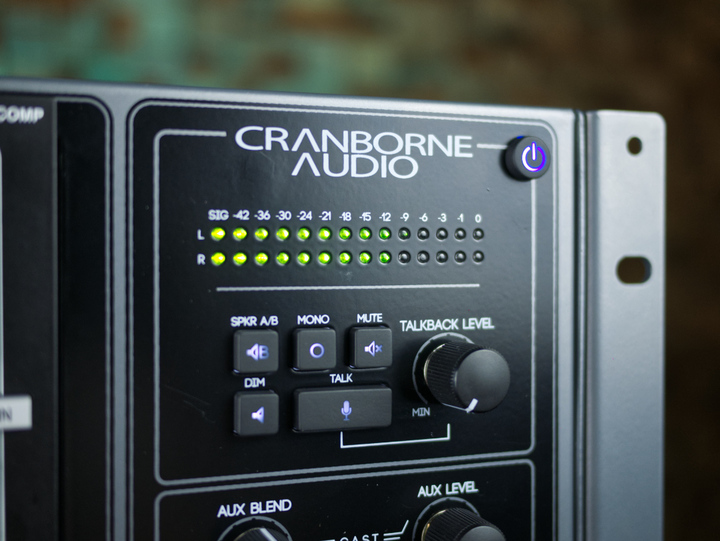
Allowing 500R8 users to control their speaker A/B selection, Mono Sum, Dim, and Talkback features during mixing and tracking duties, a built-in monitor controller is a common feature of high-end audio interfaces.
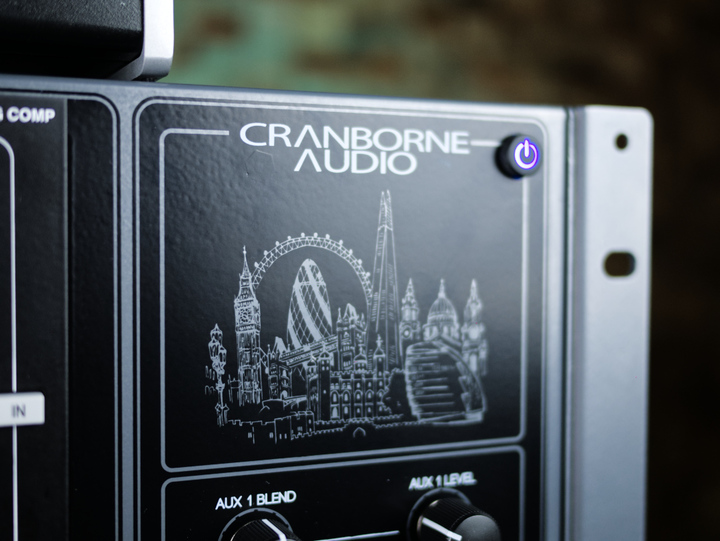
... as it was designed to connect directly to any external 3rd party audio interface that would likely feature its own monitor controller functions. To save cost and remove redundant controls, 500ADAT forgoes these facilities and instead features artwork of the London skyline in its place. The rear panel of 500ADAT also does not feature the rear I/O connectivity for speaker A/B and talkback - these connections would instead be used on the 3rd party audio interface that 500ADAT is connected to.
Part of what makes 500R8 & 500ADAT so special is the simplicity of their signal routing. All routing for each 500 series module is configured using the 'Module Source Select' switches below each slot - these determine the input fed to installed modules.
Both racks feature 'Module Source' options for C.A.S.T. and ANLG signals. C.A.S.T. corresponds to the cat 5 connections, enabling relocating analog inputs elsewhere via C.A.S.T. breakout boxes. ANLG routes rear panel XLR mic/line inputs directly to module inputs, like a standard 500 rack.
The third routing option is where 500R8 & 500ADAT differ:
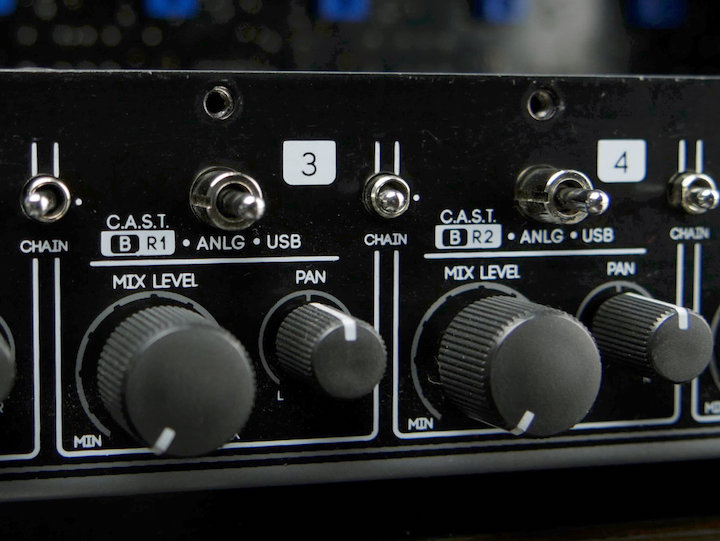
... which routes audio from the built-in USB audio interface directly into the front-end of the installed 500 Series modules.
To route audio from your DAW, configure it to output over USB channels 1-8. Then set the source switches under the 500R8 modules to 'USB'. Now, any audio sent from your DAW will reach the inputs of the installed 500 series modules directly.
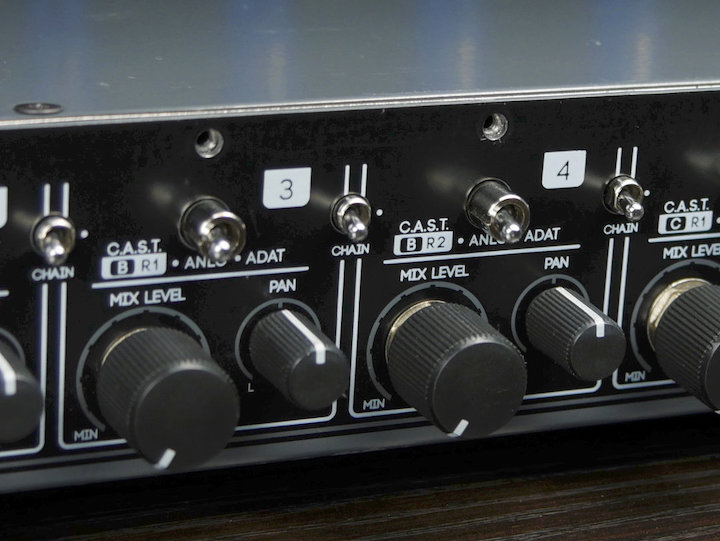
Engaging this routes audio directly from the ADAT input ports to the front end of your installed 500 Series modules.
To do this from your DAW, configure it to output over ADAT outputs 1-8. Then set the source switches under the 500ADAT modules to "ADAT". Now, any audio sent from your DAW will reach the inputs of the installed 500 series modules directly.
The input routing isn't the only difference in signal flow between 500R8 & 500ADAT. Their digital output assignments are also fixed for optimised setups:
So both racks have preconfigured digital outputs tailored for their distinct workflows - USB for the 500R8's hybrid rig integration, and ADAT for the 500ADAT's I/O expansion capabilities.
To enable greater flexibility in a studio setup, 500R8 and 500ADAT feature streamlined monitor mixing capabilities that let the engineer craft headphone mixes for musicians during recording and live tracking. A vital part of a successful monitor mix is striking the right balance between DAW playback and live channels so the musician can hear both the DAW and their instrument/voice at the same time.
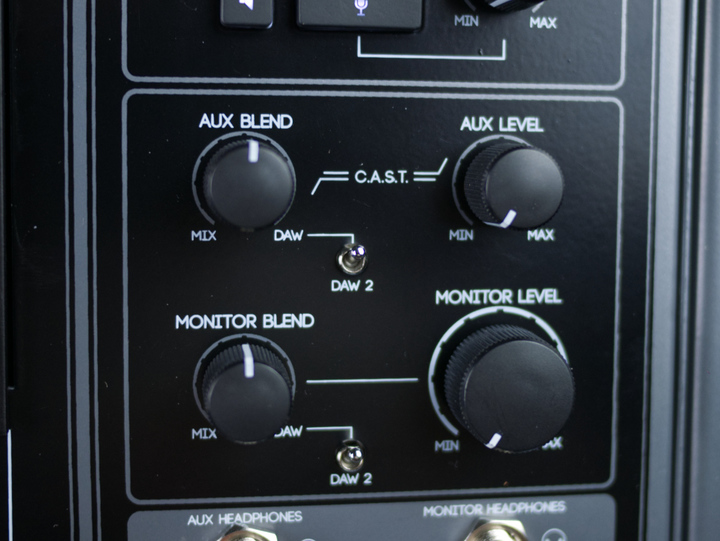
The 500R8 can achieve this simply via its built-in USB audio interface and blend controls. The 500ADAT has a similar facility when integrated with a 3rd party audio interface.
On the 500R8, DAW output gets sent through USB directly into the physical blend controls. Adjusting these changes the balance between the MIX (fully anti-clockwise), DAW playback (fully clockwise), and anything in between to mix live and pre-recorded instruments.
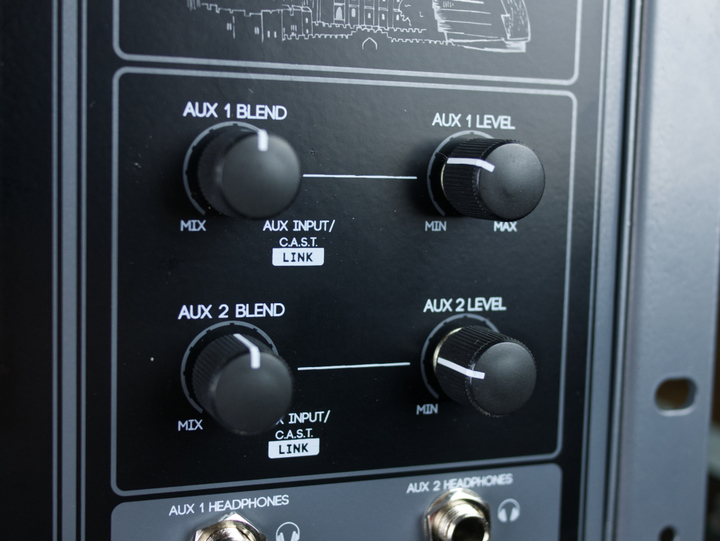
The 500ADAT, without its own USB audio, can receive a physical DAW signal from a 3rd party interface directly into its 1⁄4” jack Aux inputs. These Aux inputs connect straight to the 500ADAT's Blend control which alters the balance between MIX (fully anti-clockwise), AUX In (fully clockwise), and anything between to blend live and pre-recorded instruments.
One of Cranborne Audio's primary goals for the design of these racks lies in the potential for combining both 500R8 & 500ADAT into an expansive recording and mixing setup. Connecting 500R8 and 500ADAT together offers 16 channels of simultaneous recording, 16 channels of analogue summing, and an advanced monitoring arrangement with distributed talkback for studios seeking enhanced connectivity.
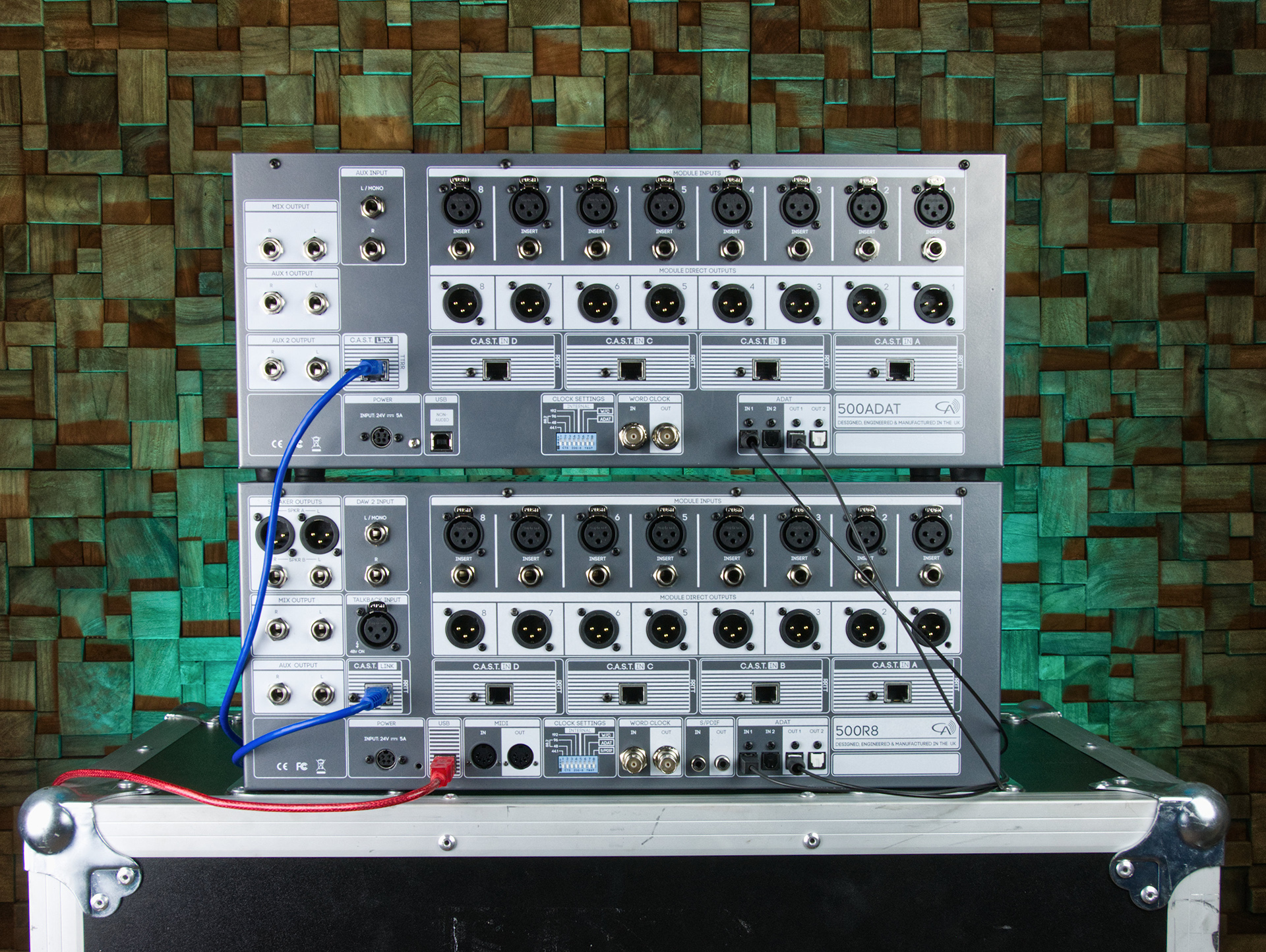
16 channels of recording
Link the two racks together using ADAT, and now the module outputs from 500ADAT feed directly into 500R8's ADAT stream, allowing direct recording into the DAW. In this setup, USB channels 1-8 correspond to 500R8's 500 Series modules, while USB channels 9-16 are dedicated to 500ADAT's installed modules.
16 channels of analogue “inserts”
Through the same connections, you can route up to 16 audio sources from your DAW directly into all 16 available 500 series slots. This enables you to insert 500 Series EQs and Comps directly into your DAW mix sessions to infuse analogue colouration into your stems. Once again, in this configuration, USB channels 1-8 are for 500R8's 500 Series modules, and USB channels 9-16 are for 500ADAT's.
16 channels of analogue summing
In addition to ADAT, you can also link the C.A.S.T. link ports of each unit to double the summing mixer channels, expanding it to 16 channels. This allows you to route 16 DAW audio channels directly into each 500 series module on both 500ADAT and 500R8, creating a stereo mix by utilising the mix level and pan controls beneath each slot. You can then record the summed analogue stereo mix via a dedicated DAC directly into USB channels 27/28. The C.A.S.T. connection between 500ADAT and 500R8 is entirely analogue, free from latency, and sums through 500R8's summing mixer before recording via USB.
More monitoring possibilities
The C.A.S.T. link connection between each rack also offers expanded possibilities for headphone monitoring. Through this analogue C.A.S.T. connection, the aux mix generated on 500R8 is sent down C.A.S.T., allowing musicians connected to 500ADAT's headphone ports to monitor the DAW playback and the summing mix routed to 500R8. This connection also carries the talkback functionality from 500R8 directly to the musicians linked to 500ADAT, enabling all connected musicians to hear talkback from the engineer associated with 500R8. The mix produced on 500ADAT is also accessible at the blend control of 500R8, allowing both the engineer and musicians to monitor the mix created on 500ADAT.
So with all of this in mind, which rack should you consider when making a purchasing decision? Both offer the same high-headroom analogue summing mixer, uncompromising analogue and digital circuit design, ultra-low jitter internal clock, zero-latency artist monitoring system, and C.A.S.T. integration but each rack satisfies a unique workflow depending on your current studio setup.
When deciding between them your decision boils down to one essential question, are you looking to replace you current audio interface or offer 500 series and analogue integration into your current audio interface. As such, we have devised a simple flow-chart below to consider:

While the differences between the 500R8 & 500ADAT are relatively small, those differences do make each of these racks unique for different studio applications, depending on what your setup and workflow is. Whether you're new to the 500 series or have been using and collecting recording gear for a while, both 500R8 & 500ADAT offer huge flexibility and connectivity for your studio.
Further Reading
If you’re interested in learning more about 500R8 and 500ADAT, when why not check out the User Manuals below for more information on each element of the racks and how they work in practise. The Manuals also feature a comprehensive set of technical specifications that detail their conversion and analogue performance.
If you need some modules to fill your rack with, why not check out our Camden 500 preamp and signal processor. An award winning preamp, Camden 500 is extremely versatile offering the cleanest and most transparent front-end on the market alongside a variable harmonic saturation effect that emulates the transformer effects of yesteryear. You can read more about Camden's transformless design, how MOJO works, as well as how we can make Camden 500 sound so good for the price back on our 'Knowledge' Blog page.
Also check out Carnaby 500, the worlds first HarmonicEQ®! Carnaby 500 is a 3-band parametric EQ for the 500 series format with a unique and revolutionary EQ concept conceived and created by Cranborne Audio. An analogue EQ that uses harmonic saturation to boost and cut frequency content, it enhances your sources, stems and mixes with genuine analogue harmonic saturation with the feel, familiarity, and control of a regular equaliser.
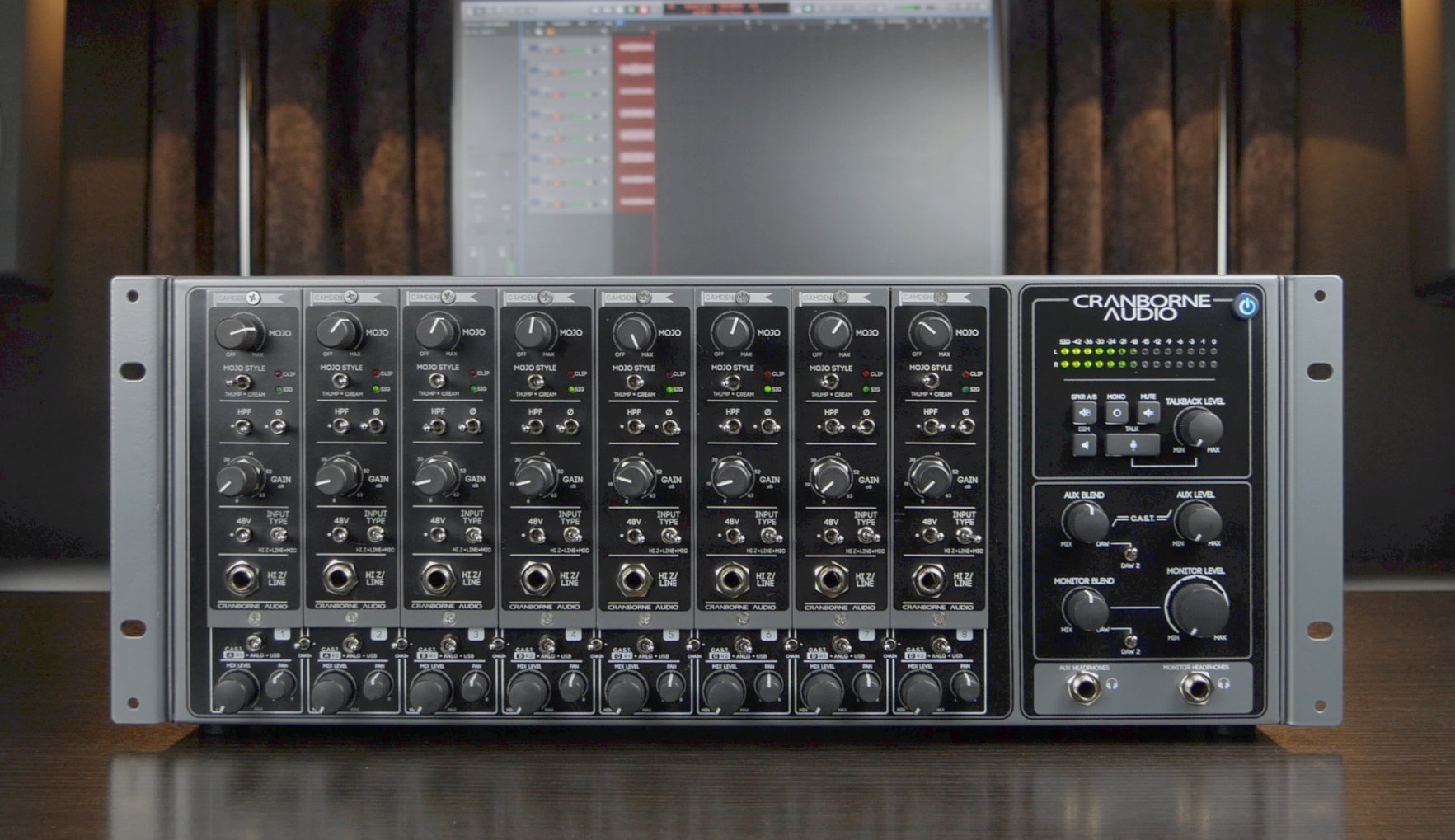
Receive the latest product updates directly from the team.

Cranborne Audio, Harvest House, Cranborne Rd, Potters Bar, EN6 3JF
Privacy Policy | Warranty Policy